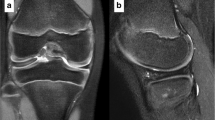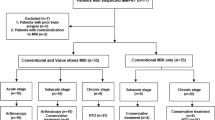Abstract
Introduction
We evaluated the efficacy of two positioned magnetic resonance imaging (MRI) for visualizing the snapping phenomenon and detecting peripheral rim instability (PRI) in no-shift-type complete discoid lateral meniscus (CDLM).
Materials and methods
The records of 39 patients diagnosed with no-shift-type CDLM under routine MRI who underwent arthroscopic surgery were reviewed. The snapping phenomenon and meniscal shift on two positioned MRI in full extension and deep flexion were evaluated and calculated the agreement between these findings. The positive predictive value (PPV), sensitivity, and specificity of meniscal shift on two positioned MRI for predicting PRI were calculated; PRI was further investigated according to anterior and posterior location. The hypotheses of this study were asfollows: (1) Two positioned MRI can visualize the snapping phenomenon and (2) Meniscal shift on two positioned MRI is an important predictive sign of detecting the instability site in no-shift-type CDLM.
Results
The κ values between the snapping phenomenon and meniscal shift on two positioned MRI were 0.84. The snapping and two positioned MRI findings had high PPV (1.0, 0.96), sensitivity (0.82, 0.85), and specificity (1.0, 0.91) for predicting overall PRI. For anterior PRI, the snapping and posterior shift on two positioned MRI had moderate and high PPV (0.78, 0.9), high sensitivity (0.9, 0.9), and specificity (0.8, 0.89). The anterior shift on two positioned MRI findings predicted posterior PRI with high PPV (1.0) and specificity (1.0).
Conclusions
Two positioned MRI visualized the snapping phenomenon. Meniscal shift on two positioned MRI was an important predictive sign of overall PRI, anterior PRI, and posterior PRI in no-shift-type CDLM.



Similar content being viewed by others
References
Watanabe M, Takeda S, Ikeuchi H (1978) Atlas of arthroscopy. Igaku-Shoin, Tokyo
Smillie IS (1948) The congenital discoid meniscus. J Bone Joint Surg Br 30:671–682
Restrepo R, Weisberg MD, Pevsner R, Swirsky S, Lee EY (2019) Discoid meniscus in the pediatric population: emphasis on MR imaging signs of instability. Magn Reson Imaging Clin N Am 27:323–339
Kramer DE, Micheli LJ (2009) Meniscal tears and discoid meniscus in children: diagnosis and treatment. J Am Acad Orthop Surg 17:698–707
Good CR, Green DW, Griffith MH et al (2007) Arthroscopic treatment of symptomatic discoid meniscus in children: classification, technique, and results. Arthroscopy 23:157–163
Atay OA, Pekmezci M, Doral MN et al (2007) Discoid meniscus: an ultrastructural study with transmission electron microscopy. Am J Sports Med 35:475–478
Cui JH, Min B-H (2007) Collagenous fibril texture of the discoid lateral meniscus. Arthroscopy 23:635–641
Papadopoulos A, Kirkos JM, Kapetanos GA (2009) Histomorphologic study of discoid meniscus. Arthroscopy 25:262–268
Klingele KE, Kocher MS, Hresko MT et al (2004) Discoid lateral meniscus: prevalence of peripheral rim instability. J Pediatr Orthop 24:79–82
Aichroth PM, Patel DV, Marx CL (1991) Congenital discoid lateral meniscus in children. A follow-up study and evolution of management. J Bone Joint Surg Br 73:932–936
Pellacci F, Montanari G, Prosperi P, Galli G, Celli V (1992) Lateral discoid meniscus: treatment and results. Arthroscopy 8:526–530
Ahn JH, Lee YS, Ha HC et al (2009) A novel magnetic resonance imaging classification of discoid lateral meniscus based on peripheral attachment. Am J Sports Med 37:1564–1569
Yoo WJ, Lee K, Moon HJ et al (2012) Meniscal morphologic changes on magnetic resonance imaging are associated with symptomatic discoid lateral meniscal tear in children. Arthroscopy 28:330–336
Yamasaki S, Hashimoto Y, Takigami J et al (2017) Risk factors associated with knee joint degeneration after arthroscopic reshaping for juvenile discoid lateral meniscus. Am J Sports Med 45:570–577
Kang MS, Kim JM, Park SS, Bin SI (2019) Prediction of the peripheral rim instability of the discoid lateral meniscus in children by using preoperative clinicoradiological factors. J Pediatr Orthop 39:e761–e768
Yoo WJ, Choi IH, Chung CY et al (2008) Discoid lateral meniscus in children: limited knee extension and meniscal instability in the posterior segment. J Pediatr Orthop 28:544–548
Hashimoto Y, Kazuya N, Takigami J, Yamasaki S, Tomihara T, Shimada N, Nakamura H (2020) Abnormal displacement of discoid lateral meniscus with snapping knee detected by full extension and deep flexion MRI: report of two cases. Asia Pac J Sports Med Arthrosc Rehabil Technol 10(21):1–4
Nakagawa S, Kadoya Y, Kobayashi A, Tatsumi I, Nishida N, Yamano Y (2003) Kinematics of the patella in deep flexion. Analysis with magnetic resonance imaging. J Bone Joint Surg Am 85:1238–1242
Komatsu T, Kadoya Y, Nakagawa S, Yoshida G, Takaoka K (2005) Movement of the posterior cruciate ligament during knee flexion–MRI analysis. J Orthop Res 23:334–339
Logan M, Dunstan E, Robinson J, Williams A, Gedroyc W, Freeman M (2004) Tibiofemoral kinematics of the anterior cruciate ligament (ACL)-deficient weightbearing, living knee employing vertical access open “interventional” multiple resonance imaging. Am J Sports Med 32:720–726
Kim E, Kim YJ, Cha JG, Kim MY, Lee DH, Cho SG, Kim RS (2015) Kinematic change of the meniscus and the tibiofemoral joint space in asymptomatic volunteers using a wide bore 3T closed MRI system. Skeletal Radiol 44:1441–1451
Moser MW, Dugas J, Hartzell J et al (2007) A hypermobile Wrisberg variant lateral discoid meniscus seen on MRI. Clin Orthop 456:264–267
Kim JH, Ahn JH, Kim JH, Wang JH (2020) Discoid lateral meniscus: importance, diagnosis, and treatment. J Exp Orthop. 7(1):81
Yue BW, Gupta AK, Moorman CT 3rd, Garrett WE, Helms CA (2011) Wrisberg variant of the discoid lateral meniscus with flipped meniscal fragments simulating bucket-handle tear: MRI and arthroscopic correlation. Skeletal Radiol 40:1089–1094
Harato K, Niki Y, Nagashima M, Masumoto K, Otani T, Toyama Y, Suda Y (2015) Ascopy arthroscopic visualization of abnormal movement of discoid lateral meniscus with snapping phenomenon. Arthrosc Tech 4(3):e235–e238
Marchand AJ, Proisy M, Ropars M, Cohen M, Duvauferrier R, Guillin R (2012) Snapping knee: imaging finding with an emphasis on dynamic sonography. Am J Roentgenol 199(1):142–150
Tamai K, Buser Z, Paholpak P, Sessumpun K, Hsieh PC, Nakamura H, Wang JC (2018) MRI kinematic analysis of T1 sagittal motion between cervical flexion and extension positions in 145 patients. Eur Spine J 27(5):1034–1041
Paholpak P, Shah I, Acevedo-Moreno LA, Tamai K, Buser Z, Wang JC (2019) Thoracic spine disc degeneration, translation, and angular motion: an analysis using thoracic spine kinematic MRI (kMRI). J Clin Neurosci 66:113–120
Jin B, Zhen J, Wei X, Zhou Y, Bian W, Yang J, Fan ZJ (2020) Evaluation of the peripheral rim instability of the discoid meniscus in children by using weight-bearing magnetic resonance imaging. Comput Assist Tomogr. https://doi.org/10.1097/RCT.0000000000001122
Acknowledgements
We thank Jane Charbonneau, DVM, from Edanz Group (https://en-authorservices.edanzgroup.com/) for editing a draft of this manuscript.
Funding
No funding was received to assist with the preparation of this manuscript.
Author information
Authors and Affiliations
Contributions
YH: Conception and design. Drafting of the article. KN: Drafting of the article, and acquisition of the data. SY: revised the work critically for important intellectual content. YN: Interpretation of data. ST: analysis of the data. HN: Conception and design, final approval of the article. All authors read and approved the final manuscript.
Corresponding author
Ethics declarations
Conflict of interest
The authors declare that they have no conflict of interest.
Ethical approval
Institutional Review Board/Ethics Committee approval number: 2968.
Informed consent
Informed consent was obtained from all individual participants included in the study.
Additional information
Publisher's Note
Springer Nature remains neutral with regard to jurisdictional claims in published maps and institutional affiliations.
Supplementary Information
Below is the link to the electronic supplementary material.
Supplementary file1 (WMV 6422 KB)
Rights and permissions
About this article
Cite this article
Hashimoto, Y., Nishino, K., Yamasaki, S. et al. Two positioned MRI can visualize and detect the location of peripheral rim instability with snapping knee in the no-shift-type of complete discoid lateral meniscus. Arch Orthop Trauma Surg 142, 1971–1977 (2022). https://doi.org/10.1007/s00402-021-04148-9
Received:
Accepted:
Published:
Issue Date:
DOI: https://doi.org/10.1007/s00402-021-04148-9




